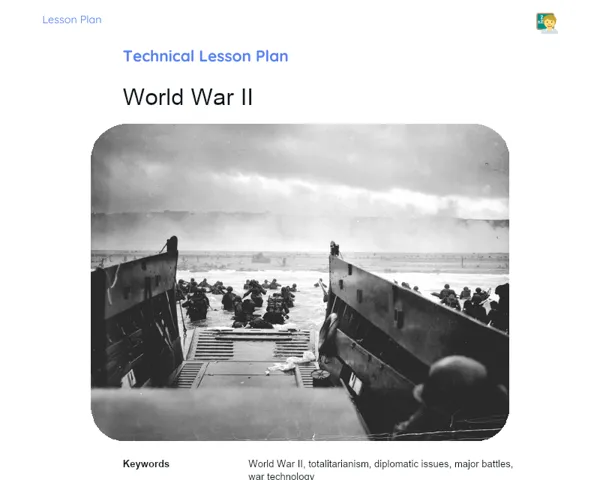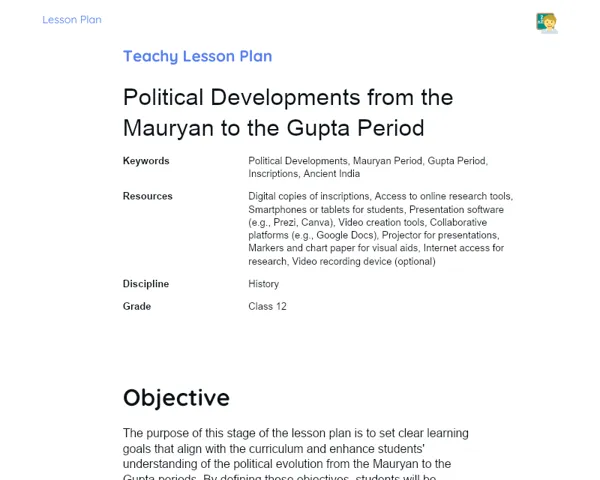Lesson Plan | Lesson Plan Tradisional | Latin American Independences: Review
| Keywords | Independence in Latin America, Geopolitical reorganization, Conflicts, Latin American society, Simón Bolívar, José de San Martín, Dom Pedro I, Internal and external causes, Enlightenment philosophies, Atlantic revolutions, Napoleonic invasions, Social and economic impacts, Creole elites, Indigenous and Afro-descendant communities |
| Resources | Whiteboard or chalkboard, Markers or chalk, Multimedia projector, Computer or laptop, Presentation slides, Paper and pens for student notes, Books and reference materials concerning Latin American Independence |
Objectives
Duration: 10 - 15 minutes
This stage aims to create a solid and detailed foundation for what will be discussed in class, giving students an outline of the main themes and concepts that will be delved into. This approach will help focus the students' attention and ensure clarity on the lesson's objectives, aiding in their comprehension and encouraging participation in subsequent activities.
Objectives Utama:
1. To grasp the independence movements in Latin America by examining their causes and effects.
2. To identify the geopolitical shifts that arose from independence and their influence on Latin American societies.
3. To acknowledge the significant conflicts and key players involved in the pursuit of independence.
Introduction
Duration: 10 - 15 minutes
This stage aims to set the context for the lesson, providing students with an overview of the independence movements in Latin America. By discussing the historical backdrop and sharing interesting facts, it seeks to ignite the students' curiosity and prepare them for a more in-depth exploration of the events, conflicts, and geopolitical transformations that will be covered in class.
Did you know?
Did you know that Brazil's independence movement was relatively peaceful compared to other Latin American countries? While many nations engaged in intense warfare, Brazil proclaimed its independence from Portugal in 1822 with the famous declaration by Dom Pedro I: 'Independência ou Morte!' This unique aspect stands out in Latin American independence narratives and highlights the complex tapestry of events across the region.
Contextualization
Latin America went through a transformative phase during the 18th and 19th centuries, marked by independence struggles that led to the formation of new nation-states. This movement was influenced by various global events, notably the French Revolution, the American War of Independence, and the Napoleonic invasions in Europe. The Spanish and Portuguese colonies in the Americas were significantly affected by these changes, spurring independence movements aimed at achieving political autonomy from European colonial rulers. This era saw the rise of iconic figures like Simón Bolívar, José de San Martín, and Dom Pedro I, who inspired the quest for freedom and the foundation of new nations.
Concepts
Duration: 50 - 60 minutes
This stage is designed to deepen students' understanding of the independence processes in Latin America by exploring the key events, conflicts, and social changes in detail. By providing a thorough explanation of the topics, the teacher ensures that students comprehend the complexities and nuances of the independence movements and their enduring impacts. The questions posed encourage critical thinking and the practical application of knowledge, aiding in content retention.
Relevant Topics
1. Causes of Independence in Latin America: Discuss the internal and external factors that sparked the independence movements, emphasizing the impact of Enlightenment ideas, the colonial crisis, Atlantic revolutions (like the American and French Revolutions), and the Napoleonic invasions of the Iberian Peninsula.
2. Main Conflicts and Movements: Outline the principal conflicts and independence movements, covering the Mexican War of Independence, Simón Bolívar's campaigns in the Andean region, José de San Martín's contributions in the Southern Cone, and Brazil’s independence led by Dom Pedro I.
3. Geopolitical Reorganization: Explain how independence led to the creation of new nation-states in Latin America. Discuss the disintegration of the old viceroyalties and captaincies into multiple countries, along with the establishment of new borders. Describe how these newly formed states began to organize politically and economically.
4. Impact on Latin American Society: Examine the social and economic shifts resulting from independence, such as the abolition of colonial privileges, the persistence of Creole elites in power, the struggles of Indigenous and Afro-descendant communities, and changes in agricultural and urban structures.
5. Iconic Figures: Highlight key leaders of the independence movements. Emphasize the roles of Simón Bolívar, José de San Martín, Dom Pedro I, and Miguel Hidalgo, along with other noteworthy figures, explaining their contributions and legacies to the emergence of new nations.
To Reinforce Learning
1. What were the key external influences that fueled the independence movements in Latin America?
2. How did the independence movements reshape the geopolitical landscape of the region?
3. What challenges did the newly independent Latin American countries encounter?
Feedback
Duration: 20 - 25 minutes
This stage serves to reinforce students' learning through a guided discussion of the topics covered in class. It allows students to revise and reflect upon the content, clarify any doubts, and make connections between the different subjects explored. Engaging students actively by encouraging them to respond to and debate the proposed questions promotes a deeper understanding and retention of the material.
Diskusi Concepts
1. What were the main external influences that contributed to the independence movements in Latin America? Explanation: Enlightenment philosophies promoting ideas of liberty, equality, and fraternity significantly influenced Latin American colonies, while the American and French Revolutions offered examples for colonies striving for independence. Additionally, the Napoleonic invasions created a power vacuum in the metropolises, encouraging local aspirations for autonomy. 2. How did the independence movements in Latin America affect the geopolitical framework of the region? Explanation: The independence movements fragmented large viceroyalties and captaincies into smaller nation-states, establishing new borders and leading these states to develop politically and economically in unique ways, often amidst both internal and external conflicts. 3. What challenges did the newly established Latin American nations face post-independence? Explanation: The new nations grappled with significant hurdles, such as ensuring territorial integrity, developing stable governments, and integrating diverse Indigenous and Afro-descendant populations. Creole elites often retained many colonial structures, perpetuating social and economic disparities.
Engaging Students
1. What were the main social implications of the independence movements in Latin America? 2. How did influential leaders like Simón Bolívar and José de San Martín shape the independence movements? 3. What might have transpired if Enlightenment ideas had not reached Latin America? 4. In what ways did the independence movements across Latin America inspire similar movements in other parts of the world? 5. What are the parallels and contrasts between the independence processes in Brazil and those of other Latin American countries?
Conclusion
Duration: 10 - 15 minutes
The aim of this stage is to review and solidify the key points discussed throughout the lesson, ensuring students develop a coherent and comprehensive understanding of the content. By summarizing the primary topics, linking theory to practical examples, and underscoring the subject’s relevance, the teacher aids students in retaining knowledge and comprehending the significance of the topic explored.
Summary
['The independence movements in Latin America were shaped by various internal and external factors, including Enlightenment ideas, Atlantic revolutions, and the turmoil caused by Napoleonic invasions.', "Major independence movements include the Mexican War of Independence, Simón Bolívar's military campaigns, José de San Martín's efforts in the Southern Cone, and Brazil's independence spearheaded by Dom Pedro I.", 'The independence process led to the division of large viceroyalties and captaincies into smaller national entities, marked by new borders and political and economic reorganization.', 'Significant social and economic shifts occurred post-independence, such as the end of colonial privileges and the ongoing dominance of Creole elites, impacting Indigenous and Afro-descendant communities.', 'Prominent figures like Simón Bolívar, José de San Martín, Dom Pedro I, and Miguel Hidalgo played crucial roles in the independence movements and the formation of new Latin American nations.']
Connection
This lesson connects theoretical knowledge with practical instances by illustrating how Enlightenment ideas and global happenings significantly influenced independence movements in Latin America. By analyzing key figures and specific conflicts, students could observe tangible examples of how these historical phenomena unfolded and shaped the genesis of modern Latin American nations.
Theme Relevance
Grasping the independence movements in Latin America is essential for understanding the national identities that emerged and the socio-political dynamics that continue to influence the region today. Modern social inequalities and power structures can be traced back to the decisions and events of the independence era. Furthermore, familiarizing students with these histories fosters a deeper appreciation of the intricate cultures and complexities of Latin American countries.



